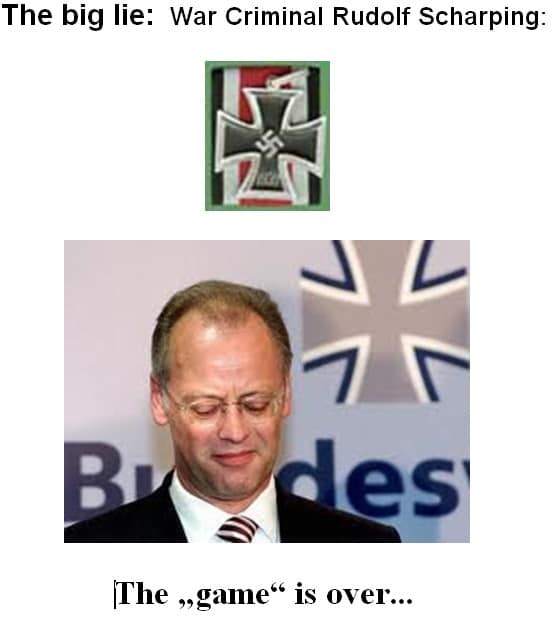by Sir Vojislav Milosevic Director, Center for Counter-terrorism & World Peace
“These photos clearly show the massacre perpetrated on 29. January in the vicinity of Rugovo, confirming that the plan for the expulsion of the “Kosovars”was put in action.“
In Kosovo, the Albanian terrorist movement linked with Germany and USA and escalated their activity toward NATO intervention. Serbs fought against well equipped Albanian armed forces which coordinated their military activity with the help of NATO. The American 30 tons of depleted uranium will continue raging for the next 4.5 billion years of half-life.
All weapons that contain DU are considered to be radioactive poison gas weapons and as such they violate the Geneva Conventions under the 1925 Geneva Poison Gas Control Protocol.
DU weapons are a permanent terrain contaminant and have a half-life of 4.5 billion years. DU can cause DNA damage, as well as cancer, leukemia and tragic birth defects. It is a kidney, liver, and neuro-toxin. Multiple independent studies confirm this.
Under 1244 UN Resolution, Kosovo would remain part of Serbia pending a peaceful resolution of its status. That UN Resolution was blatantly ignored by the US, German and other EU parties in 2008.
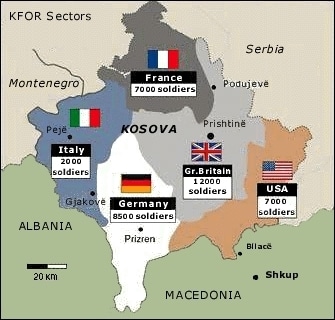
Kosovo is a tiny parcel of land in one of the most strategic locations in all Europe from a geopolitical standpoint of the US military objective of controlling oil flows and political developments from the oil-rich Middle East to Russia and Western Europe.
The controversial piece of real estate today called Kosovo was a part of Serbia until the NATO bombing campaign in 1999 demolished what remained of Milosevic’s Serbia.
Germany’s and Washington’s prompt recognition of Kosovo’s independence in February 2008, significantly, came days after elections for President in Serbia confirmed pro-Washington, it means anti-Serbian, Boris Tadic had won a second four year term.
With Tadic’s post secured, Washington could count on a compliant Serbian reaction to its support for Kosovo. It means that Boris Tadic as elected President of Serbia betrayed the Constitution Act as the supreme law of any country, and became a traitor of the highest level…
 Some of the falsehoods presented as fact about what was happening in Yugoslavia in the 1990s in order to justify foreign intervention have been long known, but they remain unacknowledged by the mainstream media. A recent German TV program about Rudolf Scharping, former German defence minister, is a notable exception.
Some of the falsehoods presented as fact about what was happening in Yugoslavia in the 1990s in order to justify foreign intervention have been long known, but they remain unacknowledged by the mainstream media. A recent German TV program about Rudolf Scharping, former German defence minister, is a notable exception.
The Sarajevo market bomb was not set by Serbs but by Bosnian Muslims, as the UN later confirmed. The skeletal “Serb concentration camp” victim was a nonsense, as the BBC’s John Simpson confirmed and the “10,000 deaths in Kosovo” were proved to be a complete myth.
The Commander of the OSCE’s Kosovo Verification Mission in 1999 (just before Yugoslavia was attacked), Roland Keith, and the former Canadian Ambassador in Belgrade James Bissett have both condemned the war and defended the Yugoslav Government.
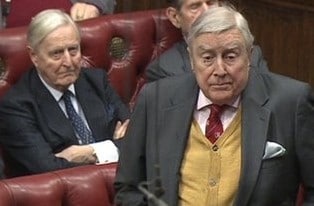
Bissett said that the 1999 attack was a “put up job” and quotes the most revealing admission by the former British Defense Minister, Lord Gilbert, who told the British House of Commons in July 2000 that the terms that NATO sought to force upon Milosevic at Rambouillet were deliberately designed to provoke war.
Commander Keith described the KLA as a terrorist organisation which had a grip on most villages in Kosovo. He had direct experience of the lies told by villagers about ethnic cleansing and he said he never saw the Yugoslav Army mistreat anyone in Kosovo.
Now we have a respected German Television program “Time Travel” broadcast in January 2012 providing clear proof of the fraud practiced by the German Government to justify to their public an attack on Yugoslavia in 1999.
It is the equivalent of the “dodgy dossier” of that other great “builder of Europe” Tony Blair, and shows the lies told by the then German Minister of Defence Rudolf Scharping to the press.
The proof came from a German policeman who actually took the photographs used by Scharping but who knew there had in fact been no “massacre” of “civilians” but a battle between armed Kosovo terrorists and Serb forces.
This is a translation of the „Time Travel“ program:
Newsreader: “We will now show you some pictures that are difficult to watch. They were made during the war in Kosovo. They are important because 13 years ago they were presented to the German public as a justification for the war against Serbia. However, those pictures were misused. This at least is the claim by the man who took them with the help of a colleague. He is from the state of Schleswig-Holstein.”
Narrator: “Henning Hensch, who is from Lutenburg, has done a great deal of thinking these last 13 years, ever since he became a part of the story of Kosovo, which had moved all Germans – the story, he claims, that fooled Germany.”
Henning Hensch: “For me, Rugovo represents an example of the use of information for political ends.”
Narrator: “As a policeman, Hensch had seen a great deal, but nothing like what he saw in the Kosovan village of Rugovo on 29. 1. 1999. More important, Hensch could not believe the way in which the event was exploited a couple of months later. The then Minister of Defence Rudolf Scharping used the photos as evidence that the Serbs had committed a massacre against the innocent unarmed Kosovo Albanians.”
Rudolf Scharping: “These photos clearly show the massacre perpetrated on 29. January in the vicinity of Rugovo, confirming that the plan for the expulsion of the “Kosovars” was put into action.”
Narrator: “However, according to Hensch who took the photos, they represented evidence of a fire fight – not a massacre. On 29. January 1999, Hensch was asked to come to Rugovo (you can see him on the left). At that time he was an OSCE observer in Kosovo.”
Henning Hensch: “When we got there, we saw a red van. As far as I can remember, there were 11 corpses, neatly stacked. Evidence of shooting could be seen on the front of the van. It was clear that it was a battle… and nothing else.”
Narrator: “A battle between the UCK rebels and Serbian forces. Three months after the event, Rudolf Scharping unveiled the photos as evidence that a massacre had been carried out on civilians.”
Rudolf Scharping: “This makes it clear that the army and the special police forces and later… gangs of released convicts and others… took part in these murders. These images are shocking…”
Narrator: “The pictures from Rugovo purported to show what the German public desperately needed – a proof that NATO air strikes against Serbia were necessary.”
Henning Hensch: “I was having breakfast in Skopje when I heard Scharping express his shock at what the Serbian “bad guys” had done to the “unarmed” Albanians.”
Interviewer: “What were your thoughts?”
Henning Hensch: “That he must be off his rocker.”
Narrator: “These are the photos that Rudolf Scharping didn’t show. He didn’t show the Albanians’ weapons, their UCK badges and membership cards and their ammunition. He didn’t show the clear evidence of fighting.”
Henning Hensch: “There can be no talk of a massacre here, and however inconvenient this might sound, these were military battles.”
Narrator: “The photos showed by Scharping were taken after the official investigation had been completed and the bodies removed by the Serbian police. Despite the fact that journalists and cameras were present, Scharping stated three months later that the photos were secretly taken and brought to Germany by a German officer.”
Rudolf Scharping: “I would very much like to introduce the lieutenant to you, but he is currently undergoing treatment as a consequence of taking these photos and the trauma they caused…”
Narrator: “We inquired at the Federal Defence Ministry if a German officer was in Rugovo at that time and if he had taken photos. After a three-week enquiry, we received the following reply: ‘To the best of our knowledge, no German officer taking photos was in Rugovo on 29. January 1999.’ Balkan experts have suspected Scharping for a long time. One of them, Konrad Clewing, has no doubt that the German government sought evidence in order to persuade the public of the need for a war in Kosovo.”
Konrad Clewing: “The Socialist/Green coalition government had just come to power in the autumn of 1998 and was desperate to prove its loyalty and ability to its doubting partners.”
Narrator: “The manoeuvre was a success. German media believed Scharping’s story of the Rugovo ‘massacre’. The message was: ‘This is why we are fighting!’ but it was propaganda according to Clewing.”
Konrad Clewing: “The propaganda strategy was further developed and primed during that week against the background of public concern.”
Henning Hensch: “I remember that the public support for military action against Serbia was falling, so they had to pressure the public… which they did using our pictures.”
Narrator: “However horrific, the photos were misused according to Henning Hensch to justify a war he considered unsupportable from the very beginning. This has made him suspicious and somewhat embittered.”
Newsreader: “We have tried several times to contact Rudolf Scharping… without success.”
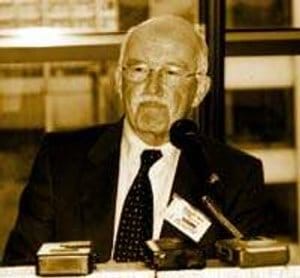
At the time of the events in the late 1990′s several prominent independent individuals spoke out against the position of the west.
Roland Keith, the Commander of the OSCE’s Kosovo Verification Mission, and James Bisset the Canadian Ambassador in Belgrade both condemned the NATO attacks on Yugoslavia.
The then British Defense Minister, Lord Gilbert, told the House of Commons in July 2000 that the terms that NATO sought to force upon Milosevic at Rambouillet were deliberately designed to provoke war.
I am convinced that in time and with the help of informed journalism such fragments of truth will be collated into a more balanced picture of the events in Kosovo in the late 1990′s.
„Rambouillet peace conference“ and „Rambouillet Accords“ were nothing else but organized theft of Serbian resources by Western corporations.
Even the Serbophobic New York Times admitted in 1998 article: “Below Kosovo, a war’s glittering prize awaits the conqueror“. However, that same media rarely mentioned the 17 trillion dollars in mineral assets of Serbia.
Serbia’s mineral resources are the richest in all Europe – west of Russia. Although the average person watching the news in the evening has never heard of „Stari Trg“, it has been a prize changing hands for 2.000 years.
The wealth of „Stari Trg“ is legendary. Precious metals were mined there more than 2.000 years ago, first by the Greeks, than by the Romans.

These mines were the grand prize in the Nazi occupation of the Balkans during the 2WW, after Germany grabbed control from the British. The mines have great industrial and military importance. The Nazis used batteries produced there to power their U-boats. Today, submarine batteries are still made there.
The enormous mineral wealth of Kosovo is never publicly discussed by U.S. President Clinton, UN Ambassador Richard Holbrooke or the Pentagon generals. They spoke only of „self-determination“ of the Albanian population of Kosovo. They never mentioned what US-imposed „self-determination“ means.
It means colonization under the guise of „liberation“, like what U.S. did to Puerto Rico, Cuba, Philippines, or elsewere, hundred years ago. Serbia wanted to preserve its industry and natural resources for the future.
In the Meantime, in Washington…
 “On behalf of the American people, I congratulate you with the fourth anniversary of your independence”, President Barack Obama said in the telegram sent to Kosovo’s “head of state” on February 17.
“On behalf of the American people, I congratulate you with the fourth anniversary of your independence”, President Barack Obama said in the telegram sent to Kosovo’s “head of state” on February 17.
According to Obama, since Kosovo’s declaration of independence the country has made significant advancement in the building of a multiethnic, pluralist and tolerant society in the heart of the Balkan area.
“In the light of your efforts to achieve European integration as the continuation of the reforms you are carrying out in the fields of politics, the economy and the rule of law, I am convinced that Kosovo will succeed in securing its full integration in the North-Atlantic community.”
The United States, Obama concluded, will remain one of Kosovo’s strongest partners and Kosovo can count on the ongoing support of the United States in building a better future.
Immediately after the bombing of Serbia in 1999, the Pentagon seized a 1000 acre large parcel of land in Kosovo at Uresevac, near the border to Macedonia, and awarded a contract to Halliburton when Dick Cheney was CEO there, to build one of the largest US overseas military bases in the world, Camp Bondsteel, with more than 7000 troops today.
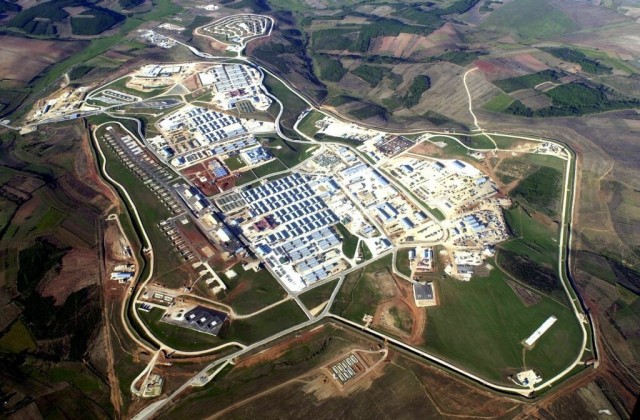
The US Secretary of State, Hillary Clinton, also sent a letter of congratulations to Kosovo’s leadership:
“Kosovo may be a young country, but you hold a promising future, and the United States is committed to supporting an independent, sovereign, multi-ethnic Kosovo. I commend Kosovo’s elected leaders for their dedication to the aspirations of the citizens of Kosovo through stronger democratic institutions, greater economic opportunities, and promoting the rule of law.
This path will lead the citizens of Kosovo to full Euro-Atlantic integration, and to lasting stability and prosperity for your country. The United States is a friend and partner, and we stand with you as we work together for a more secure, peaceful, and prosperous Kosovo. I wish all the people of Kosovo a joyous celebration and best wishes for the year to come.”
Kosovo is not recognized as a legitimate state by either Russia or Serbia or over one hundred other nations. However, it was immediately recognized when it declared independence in 2008 by the Bush Administration and by Berlin.
The US strategic agenda for Kosovo is primarily military, secondarily, it seems, narcotics trafficking. It’s prime focus is against Russia and for control of oil flows from the Caspian Sea to the Middle East into Western Europe.

It also protects the multi-billion dollar heroin trade, which, significantly, has grown to record dimensions in Afghanistan according to UN narcotics officials, since the US occupation.
Kosovo and Albania are major heroin transit routes into Europe. Kosovo is mentioned as a key point for the transfer of heroin from Turkey and Afghanistan to Western Europe.
Those drugs flow under the watchful eye of the Hashim Thaci puppet-government.
A February 22, 2005 German BND report, labeled Top Secret, which has since been leaked, stated:
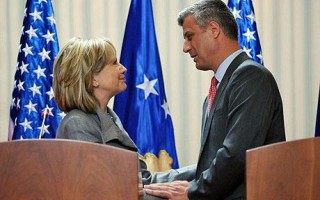
“Through the key players—for example Thaci, Haliti, Haradinaj—there is the closest interlink between politics, the economy and international organized crime in Kosovo.
The criminal organizations in the background there foster political instability.
US Secretary of State Hillary Clinton has announced that Washington will “help” Kosovo to join NATO as well as the European Union.
She made the pledge after a recent Washington meeting with Kosovo „Prime Minister“ Hashim Thaci in Washington where she praised the progress of the „Thaci government“ in its progress in “European integration and economic development.”
Editing: Jim W. Dean
Director of Center for Counter Terrorism and World Peace (Centra za Anti-Terorizam i Svetski Mir). Milosevic graduated at the Faculty for Political Sciences in Belgrade in 1980 with postgraduate studies in Islamic fundamentalism. He has worked with UNESCO and UNCTAD, a journalist, counselor at the Protocol of the Federal Parliament, speaker, politician, and book author.
ATTENTION READERS
We See The World From All Sides and Want YOU To Be Fully InformedIn fact, intentional disinformation is a disgraceful scourge in media today. So to assuage any possible errant incorrect information posted herein, we strongly encourage you to seek corroboration from other non-VT sources before forming an educated opinion.
About VT - Policies & Disclosures - Comment Policy


